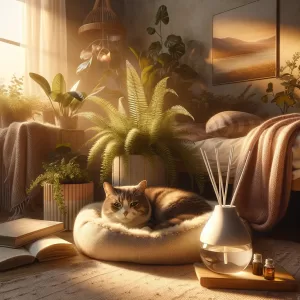Welcome to the feline playground, a magical realm where whiskers twitch, tails wag, and paws pounce. But don’t be fooled by this jubilant façade; the playground is also a classroom, a training ground where your cat learns essential life skills. What looks like mere frolic is a curriculum in disguise. Yes, your cat is not just playing; they’re attending the University of Paws and Whiskers. Let’s explore this enchanting world where fun meets learning.
Chapter 1: The Playbook: Toys as Textbooks
When you hand your cat a toy, you’re essentially handing them a textbook written in their favorite language: Play. Toys that mimic prey, like feather wands or mouse-shaped plushies, are not just for entertainment. They serve as lesson plans, teaching your cat how to channel their inner predator in a socially acceptable way.
Chapter 2: The Master Class: Feather Wands 101
Let’s delve into the Feather Wands 101 course. When your cat leaps and pounces to catch that faux bird at the end of the wand, they’re practicing their hunting techniques. They’re learning to gauge distance, sharpening their reflexes, and honing their pounce—all while burning off energy and bonding with you.
Chapter 3: Problem-Solving 101: The Interactive Toy Seminar
Interactive toys—puzzle feeders, treat-dispensing toys, and the like—are the equivalent of a seminar on problem-solving. As your cat paws, nudges, and investigates to release the hidden treasure (usually a tasty morsel), they’re developing skills that go beyond the playroom. They’re becoming little feline philosophers, contemplating the deep question: “How do I get the treat?”
Chapter 4: The Physical Education: Agility and Exercise
Let’s not forget the P.E. class in our feline university. Agility toys and tunnels give your cat a full-body workout, teaching them to navigate complex terrains. This is more than mere sport; it’s preparation for the various hurdles and challenges they may face in the wider world—or at least the living room.
Chapter 5: The Fine Arts: Creativity through Play
A session with a crinkly ball or a piece of string is like an art class for your cat. It allows them to express their creativity, approaching the ‘artwork’ from different angles, tossing it in the air, batting it around, or even just observing it with a critic’s eye. This form of play is a celebration of their individuality.
Chapter 6: The Social Studies: Group Play Dynamics
For multi-cat households, group play sessions are akin to social studies, teaching the feline participants about hierarchy, sharing, and the politics of play. Each cat learns their role—be it the leader, the follower, or the independent observer—and how to interact with others in a playful setting.
Chapter 7: The Homework: Daily Playtime
Just like any educational program, the lessons learned during play need reinforcement. Daily play sessions serve as homework, allowing your cat to practice what they’ve learned. And unlike human homework, this is one assignment they’re always eager to complete.
Chapter 8: The Parent-Teacher Conference: Observing and Adapting
As the human in this equation, your role is akin to a parent-teacher combo. Observing your cat’s play patterns can give you insights into their personality and preferences. This information allows you to adapt the ‘curriculum,’ choosing toys and games that align with their individual learning style.
Chapter 9: The Graduation: Lifelong Learning
Playtime doesn’t end when kittenhood does; it’s a lifelong course. As your cat ages, the types of play may change, but the learning continues. Senior cats may prefer more sedentary puzzles, while adolescents may crave high-energy chases. The joy of play—and its educational value—lasts a lifetime.
The Diploma in Whiskers and Tails
So, there you have it: the whimsical yet purposeful world of feline play. Each leap, pounce, and bat is a step in a journey of discovery, a class in the ever-expanding university of life. The diploma? A well-rounded, agile, and intelligent cat, equipped with the skills to navigate their nine lives with flair and finesse. 🎓🐱🎉








